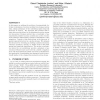Free Online Productivity Tools
i2Speak
i2Symbol
i2OCR
iTex2Img
iWeb2Print
iWeb2Shot
i2Type
iPdf2Split
iPdf2Merge
i2Bopomofo
i2Arabic
i2Style
i2Image
i2PDF
iLatex2Rtf
Sci2ools
ATAL
2003
Springer
2003
Springer
Automated derivation of behavior vocabularies for autonomous humanoid motion
In this paper we address the problem of automatically deriving vocabularies of motion modules from human motion data, taking advantage of the underlying spatio-temporal structure in motion. We approach this problem with a data-driven methodology for modularizing a motion stream (or time-series of human motion) into a vocabulary of parameterized primitive motion modules and a sets of metalevel behaviors characterizing extended combinations of the primitives. Central to this methodology is the discovery of spatio-temporal structure in a motion stream. We estimate this structure by extending an existing nonlinear dimension reduction technique, Isomap, to handle motion data with spatial and temporal dependencies. The motion vocabularies derived by our methdology provide a substrate of autonomous behavior and can be used in a variety of applications. We demonstrate the utility of derived vocabularies for the application of synthesizing new humanoid motion structurally similar to the origin...
| Added | 06 Jul 2010 |
| Updated | 06 Jul 2010 |
| Type | Conference |
| Year | 2003 |
| Where | ATAL |
| Authors | Odest Chadwicke Jenkins, Maja J. Mataric |
Comments (0)

